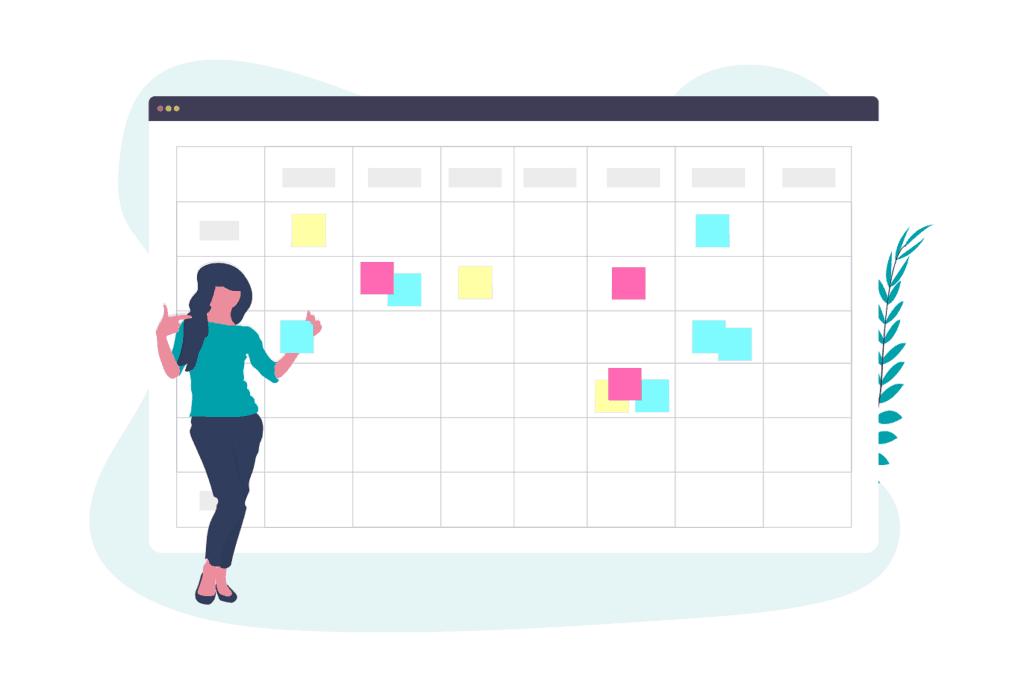How to Manage a Project
This article contains affiliate links at no cost to you #ad

You’ve got a project to manage. Congratulations! The roller coaster is about to begin!
The good news is that project management is actually made up of a series of simple steps and principles. The fundamentals of managing a project are:
- Being organized
- Helping other people be organized
- Trying to head off problems before they hinder your ability to do your work.
So, now you know that project management isn’t big or scary, let’s dig into what it is all about and how you can make your project go smoothly.
What are the 5 Stages of Project Management?
There are 5 key steps to managing a project. You’ll also hear these referred to as the project life cycle. They are:
- Initiation
- Planning
- Execution
- Monitoring and Control
- Closure.
But what do those terms actually mean?
I’m glad you asked. Let’s go!

Initiation (AKA: Work out where you are going)
The project initiation stage is where you look at what you are supposed to do and work out what life looks like once you’ve got there. In other words, set your target so you know where you are heading.
If you don’t do this, you’ll end up randomly wandering through a project wilderness and you’ll never know if you have finished or not, because you never defined what “finished” looked like.
“Would you tell me, please, which way I ought to go from here?”
“That depends a good deal on where you want to get to,” said the Cat.
“I don’t much care where…” said Alice.
“Then it doesn’t matter which way you go,” said the Cat.
“…so long as I get SOMEWHERE,” Alice added as an explanation.
“Oh, you’re sure to do that,” said the Cat, “if you only walk long enough.”
Alice’s Adventures in Wonderland, Lewis Carroll
Don’t be like Alice. Use the initiation phase to work out where you are going so it’s easier to get there.
Initiation Phase Activities
- Get clear on what the project actually entails. What are you being asked to do? By who? This person is your project sponsor. Read more about project sponsors
- Write down the project’s goals and objectives so everyone understands what is required
- Get commitment for the people needed to do the work — talk to their line managers and agree what their role on the team will be. Use a RACI or RASCI chart (they’re broadly the same thing) to help
- Get commitment for the budget required to do the work — talk to your project sponsor
Tools and documents for this step
- Project initiation checklist
- Definitive guide to Project Success Criteria (includes sample list of 20 example success criteria)
Get the Essential Project Documents template bundle that includes a project charter/project initiation template document.

Planning (AKA: How are we going to do this thing?)
Now you know where are you going. How are you going to get there? This is what you work out in the planning stage.
There are a number of approaches to planning. They all involve working as a team. However good you are at knowing your organization, you can’t know everything. Get the subject matter experts involved — it will save you so much time later on. It also builds goodwill and team spirit from the start.
However, a task list alone isn’t enough. You also need to:
- Put the tasks into a reasonable order. You can’t put the windows in a building without having the foundations and walls already built. Ordering tasks helps you work out the dependencies between then.
- Estimate the effort required. So far you’ve only got a list of tasks. Some tasks will take an hour. Others might take a week. Work out how long each task is going to take you, given the resources that you have got.
- Cost the work. Projects cost money. How much money you need depends on what you are doing. Take your big task list and estimate what budget you need for all the items.
- Add all this information together to create a project schedule. That is a comprehensive view of what work needs to be done when and by whom.
It’s also a good idea at this point to think about what might stop you from delivering your plan. Things that might make it harder for you are called risks.
For example, if you’re hosting a charity garden party, there is a risk it might rain on the day. You can plan for and manage the risk by coming up with some suggestions for how to make the impact not so bad if it happened.
You could decide to cancel the garden party 24 hours beforehand, hire a marquee so you’ve got some interior space in case of rain, issue everyone with an umbrella when they arrive, etc etc. As a team, you’ll have to choose the best approach(es) to deal with a situation before it happens.
Use the steps below as a project planning phase checklist.
Planning Phase Activities
- Make a big To Do list with the team
- Put the tasks in a logical order
- Get everyone to agree how long they think their bits will take
- Create a timeline (this could be a Gantt chart or any other way of displaying dates and tasks over time but make sure it’s something you can easily update).
Tools and documents for this step
- Excel Gantt chart template
- Advanced tool: Capacity planning
- The Essential Project Documents template bundle also includes a project plan template document.

Execution (AKA: Doing the work)
Ready to do some work? You should be.
Now you’ve got a clear step-by-step list of what to do and when it needs to be done.
Crack on.
Execution Phase Skills
While you’re doing the work, these will be useful skills to have:
- Managing team conflict
- Project reporting
- Leadership
- Meetings management.
Execution Phase Activities
- Help the team do their best work: remove roadblocks
- Do your own work too.

Monitoring and Control (AKA: Keeping everything on track)
You “monitor and control” at the same time as doing the work.
While your team are busy doing, you are busy tracking what they are doing, helping resolve problems.
Project monitoring techniques include:
- Having chats with individuals in your team about how their work is going
- Having regular team meetings to assess progress and keeping on top of actions from meeting minutes
- Learning from what happened earlier in the project and using that experience to make changes or predict behavior around what is coming next.
- Using project management software to help track what’s on target and what’s not based on timesheet data that people entered.
Basically, project monitoring and evaluation means looking at what is going on and using your professional judgement to decide if you’re happy with that.
And if you aren’t happy, you should take action to do something differently.
Monitoring and Controlling Phase Activities
- Review progress against your plan at least weekly
- Take whatever action is required to stick to the plan as closely as you can
- Talk to your sponsor if things are going wonky and you can’t fix them yourself
- Write regular project status reports
- Track any changes that are made so you’ve got a record of why they happened and what the impact was
- Deal with any problems as they come up.
Tools and documents for this step
- Project Workbook & Budget Tracker
- Project execution plan template: Use the project plan template in the Essential Project Documents template bundle as this covers all the steps to consider execute, monitor and control the project.

Project Closure (AKA: We made it!)
Closing down your project effectively is important if you want to be able to walk away from it. In some cases, you might not need to walk away, if you’ve completed something that you’ll be using and managing going forward. But for most project managers, once a project is delivered, they move on to delivering something else.
For that to happen, you need to be able to walk away.
The project closure phase is the last part of the project. It ensures you have tied up all the loose ends and the people who are going to use what you have delivered know what to do with it. We call the people receiving the end result of the project “the operational team”.
For example, if you have built a new app, the project team would be:
- Writing a user guide and other support documentation for the Marketing team
- Making sure the IT people managing the new app going forward know how it is built and what you’ve done
- Giving the operational team a guide to the system admin features so they know how to configure the app
- Training the IT helpdesk to deal with common user queries about how to use the app (never launch an IT project without telling the helpdesk it is happening! Don’t ask me how I know this…)
Use the following action steps as a project closure checklist.
Project Closure Phase Activities
- Get approval from the sponsor that they agree the project is closed
- Handover whatever the project delivered to the people who will use it going forward
- Have a final lessons learned meeting or retrospective where you dissect what worked and what didn’t work, so you can do the next project better
- Celebrate the team’s success (read 15 Ways to Celebrate Success for ideas how to do this without breaking the bank).
Tools and documents for this step
- Project closure document: use the template inside the Essential Project Documents template bundle as this covers all the areas you need to document for closing down a project.
- Lessons learned meeting agenda template
- Lessons learned meeting minutes template
And that’s it. You’ve come to the end of the project. Well done!
There is a lot to take in. But once you get started I promise it all starts to make sense and helps you feel more organized and in control.
If there are terms about project management that I’ve used in this article, or that you hear at work, this video will help. It covers some of the most common
It covers the project lifecycle (which is essentially what is described above), work breakdown structures, milestones, baselines, Gantt charts, stakeholders,
Pin it for later:


